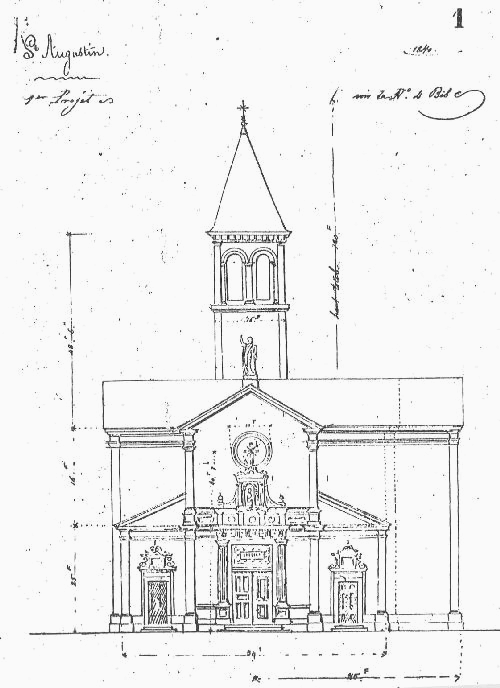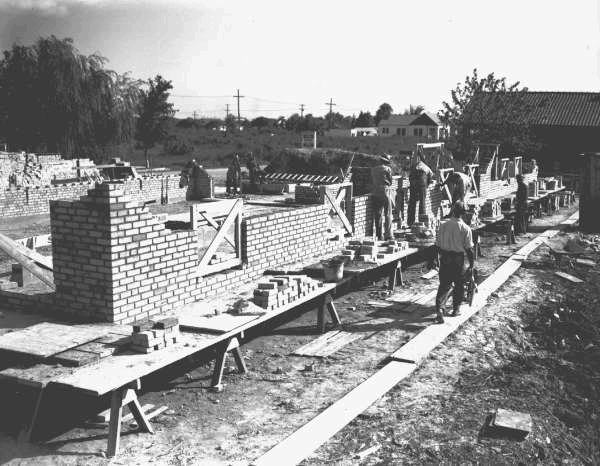|
Today in New Orleans History |
|
|
October 9

 To receive an update for each day in New Orleans history,
join our facebook page - Today in New
Orleans History.
St Augustine Church at 1210 Governor Nicholls Street is Dedicated French
Architect, J. N. B. de Pouilly's, design drawing of St. Augustine, circa 1840. The property on which St. Augustine stands was part
of the plantation estate which had been a tilery and brickyard headquarters built in 1720 by the province of New
Orleans’ supervisor, the Company of the Indies, as an economic stimulus for the province. After the Company
of the Indies left in 1731, the plantation was sold to the Moreau family, eventually coming into the possession
of Julie Moreau, a manumitted slave, in 1775. Claude Treme, a Frenchman, married Julie Moreau, thus taking title
to the property. Seeing a chance to make a profit, the husband and wife subdivided the estate and sold off many lots
on a first-come-first-served basis to free people of color and others pouring in from the Old Quarter jammed with
Haitian immigrants fleeing the bloody 1791 revolution in Haiti. After selling 35 lots, Claude and Julie Treme left their plantation
home for a more peaceful life in 1810. In 1834, Jeanne Marie Aliquot purchased the Treme’s former home and property
from the city of New Orleans and brought in the United States’ first Catholic elementary school for free girls
of color and a few slaves. This school had been started in 1823 by Marthe Fortier, a onetime postulant of the Hospital
Nuns. Jeanne Marie Aliquot became a major catalyst in the origins of St. Augustine Church. Under economic duress from her social ventures, Jeanne Marie sold the house to the
Ursuline Sisters in 1836. They in turn sold the property to the Carmelites in 1840, who then took over the little school
for colored girls and merged it with their school for white girls. The Carmelite Sisters used the Treme home for their
motherhouse until 1926 when they moved out to Robert E. Lee Boulevard in the West End section of New Orleans. In the late 1830s,
when free people of color got permission from Bishop Antoine Blanc to build a church, the Ursulines donated the corner
property at Bayou Road (now Governor Nicholls St.) and St. Claude which they had bought for $10,000, on the condition
that the church be named after their foundress, St. Angela Merici. However, circumstances dictated that the church was
named St. Augustine. A few months before the October
9, 1842 dedication of St. Augustine Church, the people of color began to purchase pews for their families to sit. Upon
hearing of this, white people in the area started a campaign to buy more pews than the colored folks. Thus, The War
of the Pews began and was ultimately won by the free people of color who bought three pews to every one purchased
by the whites. In an unprecedented social, political and religious move, the colored members also bought all the pews
of both side aisles. They gave those pews to the slaves as their exclusive place of worship, a first in the history
of slavery in the United States. This mix of the pews resulted in the most integrated congregation in the entire country: one
large row of free people of color, one large row of whites with a smattering of ethnics, and two outer aisles of slaves.
Except for a brief six-month period when its sanctuary was enlarged and blessed in time for Christmas 1925, St. Augustine
Church has been in continuous use as a place of worship until the present time. In the midst of all these things, Henriette
Delille, a free woman of color, and Juliette Gaudin, a Cuban, began aiding slaves, orphan girls, the uneducated,
the sick and the elderly among people of color around 1823. Their particular concern for the education and care
of colored children aided greatly in the founding, financing, staffing and administration of the city’s early
private schools for the colored. At the urging of Jeanne Marie Aliquot and the wise counseling of Pere Etienne Rousselin,
the two women knelt publicly at the altar of St. Augustine Church on November 21, 1842 and pledged to live in community
to work for orphan girls, the uneducated, the poor, the sick and the elderly among the free people of color, thus founding
the Congregation of the Sisters of the Holy Family, after the Oblates of Providence founded in Baltimore in 1828,
the second-oldest African-American congregation of religious women. Historical figures such as Homer Plessy,
of Plessy vs. Ferguson fame from the U.S. Supreme Court decision on May 18, 1896, and Alexander P. Tureaud, Sr., a
giant among the civil rights attorneys of the stormy sixties, were members of St. Augustine Church.  To receive an update for each day in New Orleans
history, join our facebook page
- Today in New Orleans History
Ronnie Barron (born Ronald Raymond Barrosse on October 9, 1943 in
Algiers) was known for his work as a session musician for many artists including Paul Butterfield, Canned Heat, Ry Cooder,
Tom Waits, Eric Burdon & The Animals, Delaney & Bonnie and Friends, and New Orleans' own
Dr. John (Mac Rebbenack). He played keyboards, organ, and sang. Barrosse passed away on March 20, 1997. In Louisiana, state headquarters of the WPA was located in New Orleans. The agency
also operated district offices around the state. WPA projects in the Crescent City ranged from street paving and
bridge building to bookbinding and adult education. A considerable amount of the agency's varied activities in New Orleans
and throughout the state was documented by WPA photographers. The New Orleans Public Libary holds a large collection of their work. On December 4, 1942, President Franklin Roosevelt ordered an end to WPA activities as the nation's war effort
eliminated most of the unemployment that the agency had been designed to combat.
This photograph was taken on October 9, 1939. It and the descriptions are from the New Orleans Public Library.
|
|
|

To receive an update for each day in New Orleans history,
join our facebook page - Today in New
Orleans History.
Analytics |



